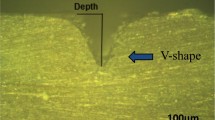Abstract
In this paper, we mainly study the processing and manufacturing methods of the Koch fractal micromixer on polymethyl methacrylate (PMMA) substrate using a flexible and low-cost CO2 laser system. The structure of Koch fractal microchannel can increase the contact area of the fluids, prolong the mixing time and improve the mixing efficiency of the micromixer. The study focuses on the effect of the CO2 laser system processing power, scanning speed and the number of scanning times on the quality of microchannel. With the increase in processing power and the number of scanning times, the width and depth of the microchannel change more obviously; this contributes to the hot-bonding success of the Koch fractal micromixer, avoiding the hot-bonding failure causes by the overvoltage or overheat. At last, the CO2 laser output power of 7 W and a laser scanning speed of 10 mm/s combining a hot press bonding technique are chosen to fabricate a microfluidic chip within half an hour. The fabrication of microchannel on PMMA substrates with CO2 laser system will have a wide range of application values, resulting in lower costs and easier fabrication.






Similar content being viewed by others
References
Chow AW (2002) Lab-on-a-chip: opportunities for chemical engineering. AIChE J 48(8):1590–1595
Oedit A, Vulto P, Ramautar R, Lindenburg PW, Hankemeier T (2015) Lab-on-a-chip hyphenation with mass spectrometry: strategies for bioanalytical applications. Curr Opin Biotechnol 31:79–85
Wang W, Soper SA (eds) (2006) Bio-MEMS: technologies and applications. CRC Press, Boca Raton
Thorsen T, Maerkl SJ, Quake SR (2002) Microfluidic large-scale integration. Science 298(5593):580–584
Pradhan P, Guan J, Lu D et al (2008) A facile microfluidic method for production of liposomes. Anticancer Res 28(2A):943–947
Frommelt T, Kostur M, Wenzel-Schäfer M, Wang PG, Lee LJ, Lee RJ (2008) Microfluidic mixing via acoustically driven chaotic advection. Phys Rev Lett 100(3):034502
Minc N, Fütterer C, Dorfman KD, Bancaud A, Gosse C, Goubault C, Viovy JL (2004) Quantitative microfluidic separation of DNA in self-assembled magnetic matrixes. Anal Chem 76(13):3770–3776
Bandara GC, Heist C, Remcho VT (2018) Chromatographic separation and visual detection on wicking microfluidic devices: quantitation of Cu2+ in surface-, ground-, and drinking water. Anal Chem 90:2594
Verpoorte E (2002) Microfluidic chips for clinical and forensic analysis. Electrophoresis 23(5):677–712
Jia ZJ, Qun Fang A, Fang ZL (2004) Bonding of glass microfluidic chips at room temperatures. Anal Chem 76(18):5597–5602
WO A (2016) Welding method of substrate and membrane of membrane mobile polymer microfluidic chip
Li B (2009) Design and fabrication of a microfluidic chip driven by dielectric elastomers, pp 74935S–74935S-9
Zhang K (2011) Integrations of advanced functional materials and devices for microfluidic applications. Hong Kong Polytechnic University
Boonyasit Y, Maturos T, Sappat A, Jomphoak A, Tuantranont A, Laiwattanapaisal W (2011) Passive micromixer integration with a microfluidic chip for calcium assay based on the arsenazo III method. Biochip J 5(1):1–7
Zukowski K, Chudy M, Dybko A, Brzózka Z (2010) Passive fluidic micromixer created by micromilling and thermal bonding in pmma. Prz Elektrotech 86(10):154–156
Mohammed MI, Desmulliez MPY (2013) The manufacturing of packaged capillary action microfluidic systems by means of CO2, laser processing. Microsyst Technol 19(6):809–818
Wang Z, Chu J, Wang Q, Zhang R (2015) Fabrication of nanochannels using underexposed nanoimprint method. IET Micro Nano Lett 10(1):34–36
Iwai K, Shih KC, Lin X, Brubaker TA, Sochol RD, Lin L (2014) Finger-powered microfluidic systems using multilayer soft lithography and injection molding processes. Lab Chip 14(19):3790
Chen X, Shen J (2015) Simulation in system-level based on model order reduction for a square-wave micromixer. Int J Nonlinear Sci Numer Simul 16(7):307
Nakashima S, Sugioka K, Midorikawa K (2009) Fabrication of microchannels in single-crystal GaN by wet-chemical-assisted femtosecond-laser ablation. Appl Surf Sci 255(24):9770–9774
Zhang SJ, Shin YC (2017) Effective methods for fabricating trapezoidal shape microchannel of arbitrary dimensions on polymethyl methacrylate (PMMA) substrate by a CO2 laser. Int J Adv Manuf Technol 93(1–4):1–16
Romoli L, Tantussi G, Dini G (2011) Experimental approach to the laser machining of PMMA substrates for the fabrication of microfluidic devices. Opt Lasers Eng 49(3):419–427
Acknowledgements
This work was supported by the Key Project of Department of Education of Liaoning Province (JZL201715401), Liaoning BaiQianWan Talents Program (2017) and Scholarship of China National Scholarship Council (201808210025).
Author information
Authors and Affiliations
Corresponding author
Additional information
Technical Editor: Márcio Bacci da Silva, Ph.D.
Rights and permissions
About this article
Cite this article
Zhang, S., Chen, X. CO2 laser ablation of microchannel on PMMA substrate for Koch fractal micromixer. J Braz. Soc. Mech. Sci. Eng. 41, 45 (2019). https://doi.org/10.1007/s40430-018-1551-4
Received:
Accepted:
Published:
DOI: https://doi.org/10.1007/s40430-018-1551-4




